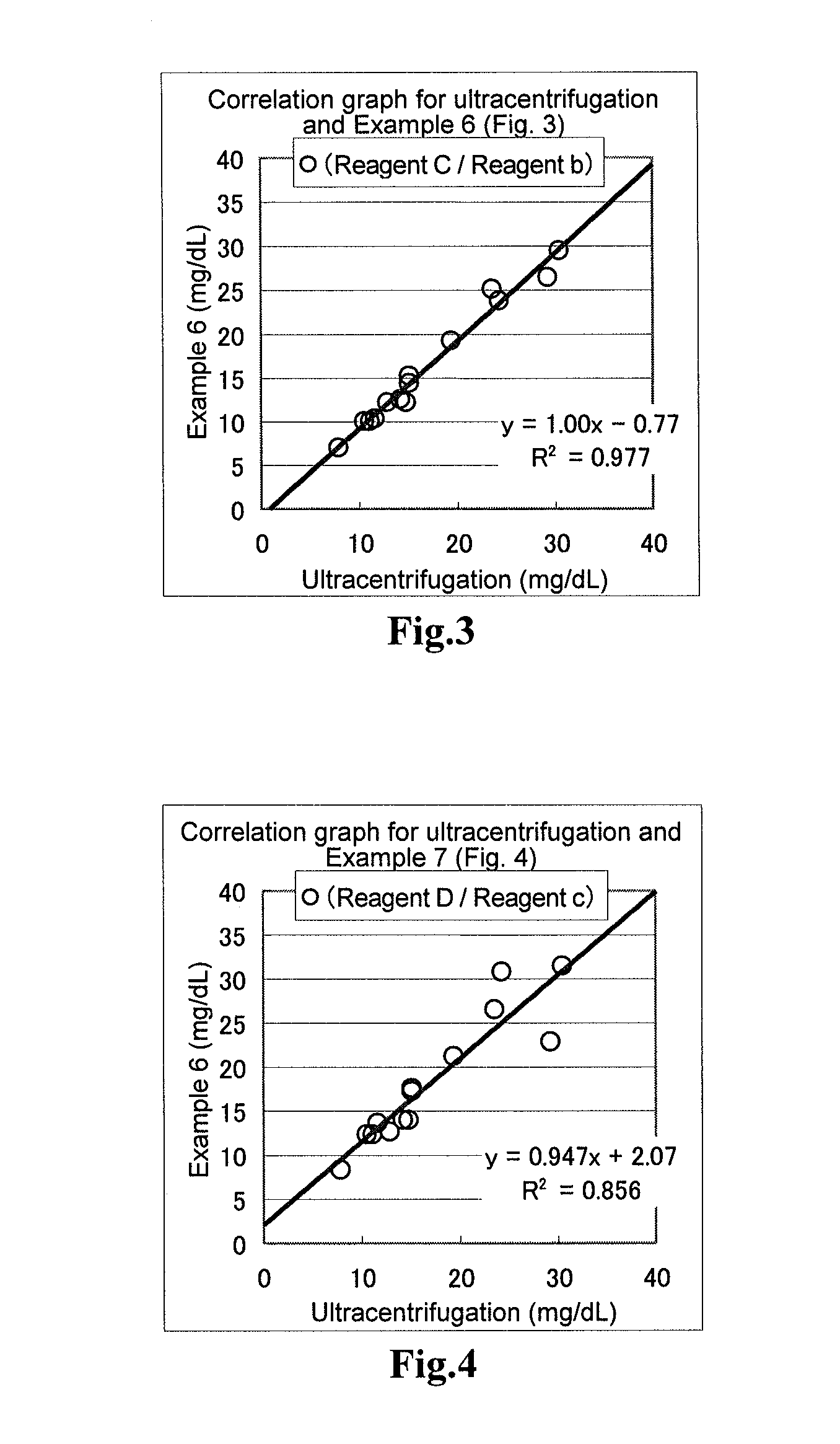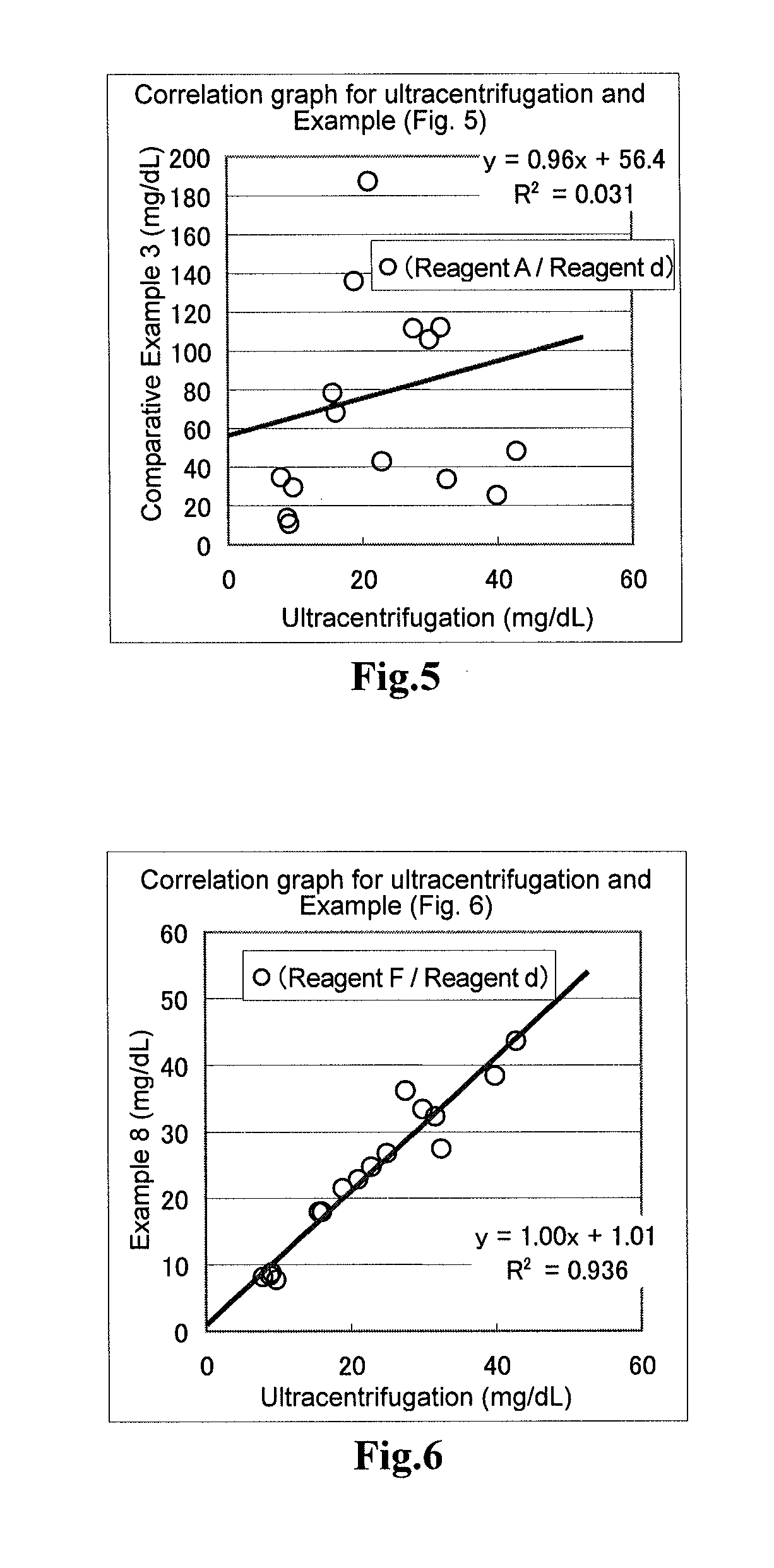Method for removal of triglycerides in lipoproteins other than low-density lipoproteins
a technology of lipoproteins and triglycerides, which is applied in the field of eliminating triglycerides in lipoproteins other than low density lipoproteins, can solve the problems of difficult quantitative recovery of samples, laborious and time-consuming operations, and difficult recovery of separated samples
- Summary
- Abstract
- Description
- Claims
- Application Information
AI Technical Summary
Benefits of technology
Problems solved by technology
Method used
Image
Examples
example 1
[0052]The LDL-TG quantification reagents having the following compositions were prepared.
[0053]
PIPES buffer (pH 6.5)50mmol / LSurfactant*32.0g / LBovine serum albumin3.0g / LTrinder Reagent (TOOS)0.5g / LMagnesium chloride4.0g / LGlycerol kinase2.0KU / LGlycerol-3-phosphate oxidase7.5KU / LLipoprotein lipase100KU / LCholesterol esterase#10.6KU / LCatalase1000KU / L*3Polyoxyalkylene derivative (HLB value, 13.2)#1About 30 kDa (derived from Pseudomonas sp.)
Second Reagent (Reagent a)
[0054]
PIPES buffer (pH 7.0)50mmol / LSurfactant*46.0g / L4-Aminoantipyrine4.0mmol / LLipoprotein lipase5.0KU / LPeroxidase5.0KU / LSodium azide0.05%*4Polyoxyethylene alkyl ether (HLB value, 13.3)
example 2
[0055]The LDL-TG quantification reagents having the following compositions were prepared.
First Reagent (Reagent C)
[0056]
PIPES buffer (pH 6.5)50mmol / LSurfactant*52.0g / LBovine serum albumin3.0g / LTrinder Reagent (TOOS)0.5g / LMagnesium chloride4.0g / LGlycerol kinase1.0KU / LGlycerol-3-phosphate oxidase4.0KU / LLipoprotein lipase0.3KU / LCholesterol esterase#20.7KU / LCatalase1000KU / L*5Polyoxyalkylene derivative (HLB value, 13.2)#2About 30 kDa (derived from Pseudomonas sp.)
Second Reagent (Reagent b)
[0057]
PIPES buffer (pH 7.0)50mmol / LSurfactant*66.0g / L4-Aminoantipyrine4.0mmol / LLipoprotein lipase400KU / LPeroxidase5.0KU / LSodium azide0.05%*6Polyoxyethylene alkyl ether (HLB value, 12.4)
example 3
[0058]In terms of the samples to used for the evaluation, a fraction containing both CM and VLDL (specific gravity, from less than 0.96 to 1.006) or fraction containing all of CM, VLDL and IDL (specific gravity, from less than 0.96 to 1.019), LDL fraction (specific gravity, from 1.019 to 1.063) and HDL fraction (specific gravity, from 1.063 to 1.210)are separated using, for example, ultracentrifugation. Each of these fraction samples was subjected to measurement of the total amount of triglycerides, and the measured amount was compared with the amounts of triglycerides quantified using the reagents of the above Examples. The ultracentrifugation was carried out according to the method described in “New Biochemistry Experiment Lecture 4: Lipid I—Neutral Lipids and Lipoproteins”, Tokyo Kagaku Dojin Publishing Company.
[0059]The reagents of Comparative Example 1, Example 1 and Example 2 were subjected to the following operations. After taking 2 μL of the sample, 195 μL of the first reage...
PUM
| Property | Measurement | Unit |
|---|---|---|
| molecular weight | aaaaa | aaaaa |
| pH | aaaaa | aaaaa |
| temperature | aaaaa | aaaaa |
Abstract
Description
Claims
Application Information
 Login to View More
Login to View More - R&D
- Intellectual Property
- Life Sciences
- Materials
- Tech Scout
- Unparalleled Data Quality
- Higher Quality Content
- 60% Fewer Hallucinations
Browse by: Latest US Patents, China's latest patents, Technical Efficacy Thesaurus, Application Domain, Technology Topic, Popular Technical Reports.
© 2025 PatSnap. All rights reserved.Legal|Privacy policy|Modern Slavery Act Transparency Statement|Sitemap|About US| Contact US: help@patsnap.com



